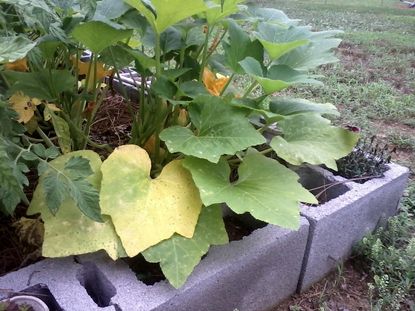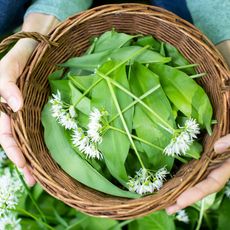Yellowing Squash Leaves: Why Squash Leaves Turn Yellow


Your squash plants were looking wonderful. They were healthy and green and lush, and then one day you noticed that the leaves were getting yellow. Now you are worried about your squash plant. Why are the leaves turning yellow? Is that normal or is something wrong?
Reasons and Fixes for Yellow Squash Leaves
Well, I hate to be the bearer of bad news, but chances are, if your squash plant leaves are turning yellow, something is wrong. The hard part is figuring out exactly what. The leaves on a squash plant will start to turn yellow any time the plant is stressed. Below, I have listed a few reasons why a squash plant may be stressed. Lack of Water While squash plants are pretty hardy plants, as far as vegetable plants go, they do need about 2 inches (5 cm.) of water a week. Sometimes they will need more due to high temperatures. Check to see if your squash plants are getting at least this much water a week. If not, supplement natural watering (i.e. rain) with a sprinkler or a drip hose. Vine Borers Vine borers will attack a squash plant and make their way through the vine of the plant. Telltale signs of a vine borer include yellowing of the leaves, gradually from the base end of the vine to the tip, and a small pile of "sawdust" at the base of the vine, near where it comes out of the ground. If you suspect a vine borer, be aware that pesticides will not work. The only effective, though not always successful, treatment is to try to remove the vine borer worm from the stem. Go to the spot where you suspect the vine borer is lodged and carefully slit the vine lengthwise (in the direction of the capillaries). This will not hurt the squash plant too much and either way, if you don't find the vine borer, the plant is doomed anyway. If you're able to locate the vine borer, use a toothpick to pierce and kill it. Iron Deficiency Without iron, plants have a difficult time making chlorophyll, the substance that makes leaves green. Adding iron chelates (a kind of fertilizer) to the soil can help. Most of the time, iron deficiency is a result of the nutrients being leached out of the soil due to overwatering. Make sure that you aren't overwatering your plants. Bacterial Wilt Unfortunately, if your squash plants are infected by bacterial wilt, there's nothing you can do to save them. The yellowing of the leaves will be followed rapidly by wilting and browning of the leaves and eventually death. Bacterial wilt can be diagnosed by cutting off a piece of the stem and squeezing out some of the juice inside. If the juice comes out slimy or oozing, then the plant has been infected. Destroy the plants and don't compost them. Don't plant squash or other cucurbit vines in that location next year, as the bacterial wilt will still be in the soil and will infect them as well. While the conditions listed above are some of the most common reasons for squash plants developing yellow leaves, they aren't the only ones. As stated above, the leaves on squash plants will turn yellow any time the plant is stressed. If you can find out what is stressing the plant, then you'll be able to remedy the situation and help your squash plant regain its green coloring.
Gardening tips, videos, info and more delivered right to your inbox!
Sign up for the Gardening Know How newsletter today and receive a free download of our DIY eBook "Bring Your Garden Indoors: 13 DIY Projects For Fall And Winter".

Heather Rhoades founded Gardening Know How in 2007. She holds degrees from Cleveland State University and Northern Kentucky University. She is an avid gardener with a passion for community, and is a recipient of the Master Gardeners of Ohio Lifetime Achievement Award.
-
 Elegant Exotics: 8 Beautiful Amaryllis Varieties That Will Brighten Any Holiday Display
Elegant Exotics: 8 Beautiful Amaryllis Varieties That Will Brighten Any Holiday DisplayWhether red, pink, white or variegated, the right amaryllis varieties can enhance any living space, especially during the holidays. We round up eight of the most exquisite
By Bonnie L. Grant
-
 Forage For Herbs: 7 Tasty And Safe Wild Herbs To Pick Close To Your Own Backyard
Forage For Herbs: 7 Tasty And Safe Wild Herbs To Pick Close To Your Own BackyardIn addition to growing your own herbal staples, did you know there are several wild options out there that are safe and tasty – and free? Try foraging these 7 wild herbs
By Amy Grant